St. Patrick's Church
Stained Glass Windows
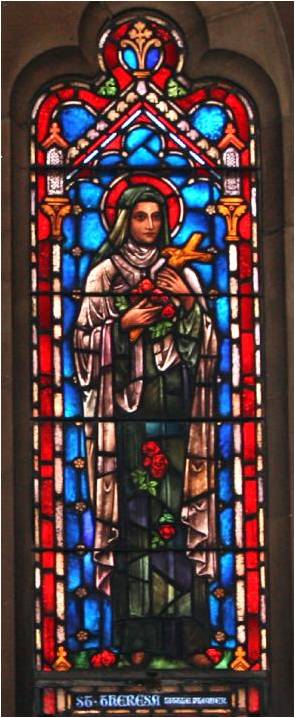
|
Therese became a Carmelite nun at age fifteen in France. She was a spiritual writer and became a doctor of the Church. She died at age 24 of tuberculosis and is the patron of missionaries although she never left the convent.
Her symbol is the rose. She said, "After my death, I will let fall a shower of roses. I will spend my heaven doing good upon earth. I will raise up a mighty host of little saints. My mission is to make God loved..."
Shortly after her death, the rain of roses began. Sometimes roses literally appeared, and sometimes just the fragrance of them.
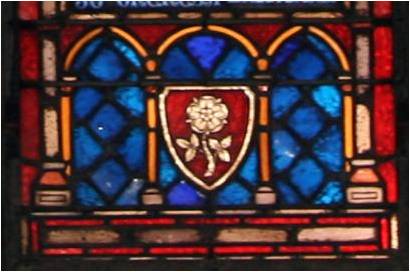
|
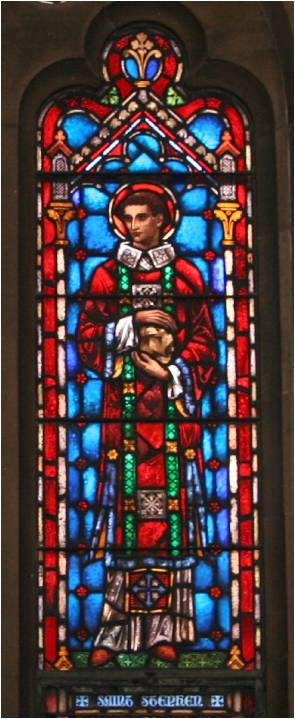
|
His story is found in the Acts of the Apostles. He was a deacon in the early church. He wears the vestments of deacon to show this. The garments are red indicating that he died a martyr's death. He was killed because he refused to stop preaching the gospel. He forgave those who were killing him.
The stones that Stephen carries in his hands and the stones shown below tell of his death by stoning.
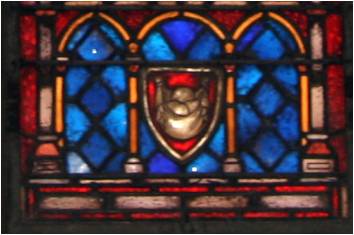
|
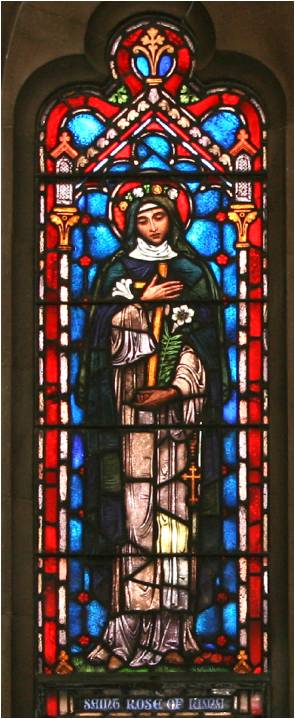
|
A sixteenth century Third Order Dominican from Peru. She was well know for her asceticism. She is shown in a Dominican habit staring at the cross with lilies, a sign of purity, in her hands. A crown of roses are on her head.
She would don a heavy crown made of silver, with small spikes on the inside, in emulation of the Crown of Thorns worn by Christ.
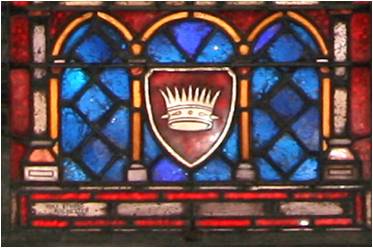
|
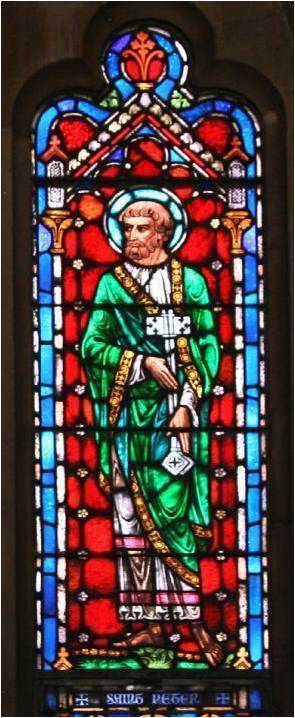
|
He carries the "keys to the Kingdom."
The New Testament clearly defines Peter as not only having a special relationship with Jesus but that he was Jesus' appointed leader of the Apostles. He was privileged to witness the Transfiguration, the raising of a child from death, the agony at Gethsemane. He was sent with John to prepare the Passover meal before Jesus' crucifixion and he was the first to enter the tomb after Jesus had risen from the dead.
The crowing rooster is a symbol of Peter's denial of Jesus found in MT 26:33. Peter said to him in reply, "Though all may have their faith in you shaken, mine will never be." Jesus said to him, "Amen, I say to you, this very night before the cock crows, you will deny me three times."
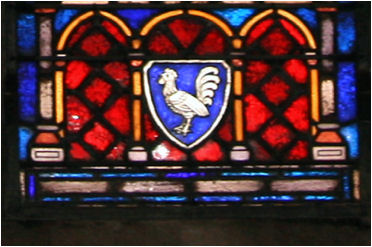
|
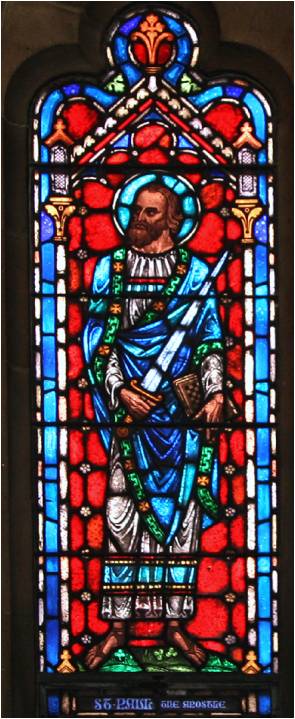
|
Paul was known as Saul of Tarsus before his conversion. He embarked on three missionary journeys that took him to Syria, Cyprus, Asia Minor, Macedonia, Greece and elsewhere. Paul was martyred in Rome, probably by beheading, in 68 A.D.
The sword that Paul carries is a symbol of righteousness.
Paul's shield shows an open Bible on which the words Spiritus Gladius are written. St Paul himself interprets this symbol for us in his words to the Ephesians (6:17): "Take the helmet of salvation, and the sword of the Spirit, which is the Word of God." Paul spoke of the Word of God as the "Sword of the Spirit." Paul was Christianity's greatest preacher.
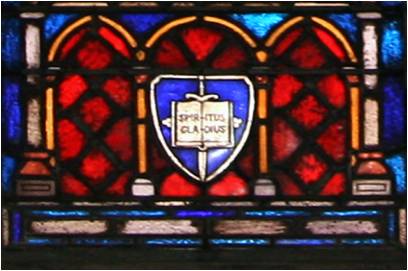
|
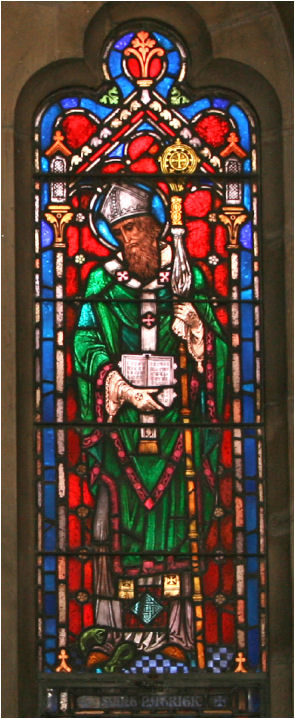
|
He was a missionary to Ireland and became bishop as shown by the mitre and crozier he wears. The absence of snakes in Ireland gave rise to the legend that they had all been banished by St. Patrick chasing them into the sea after they attacked him during a 40-day fast he was undertaking on top of a hill. Therefore, Patrick is shown stepping on serpents
The harp is a symbol of Ireland the land where Patrick preached the Gospel and converted people to Christ.
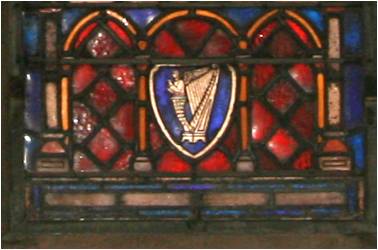
|
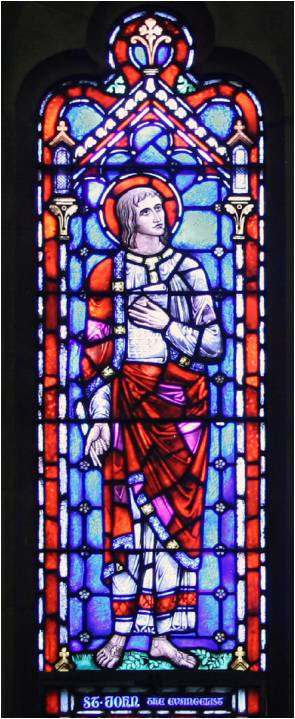
|
He was the writer of the fourth gospel. He is pictured with a book and a pen and is looking upward. John's gospel speaks more to Jesus' divinity, which is called high Christology.
The cup with the snake in it refers to a legend that someone tried to poison John. He drank the poison but was spared death. He is the only apostle to die a natural death.
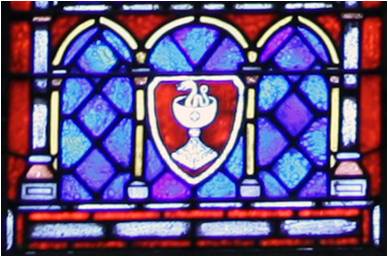
|
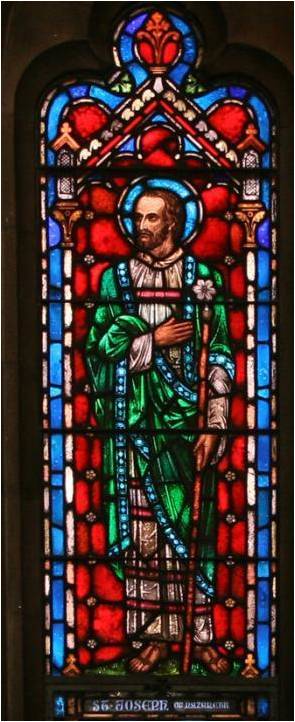
|
He was a Jesuit priest, missionary and martyr who traveled and worked among the native populations in North America.
An open book represents truth and revelation in particular the truth of the Cross, which is what Isaac Jogues preached to the Native Americans.
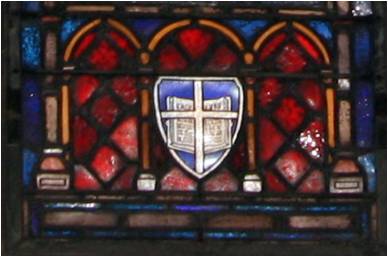
|
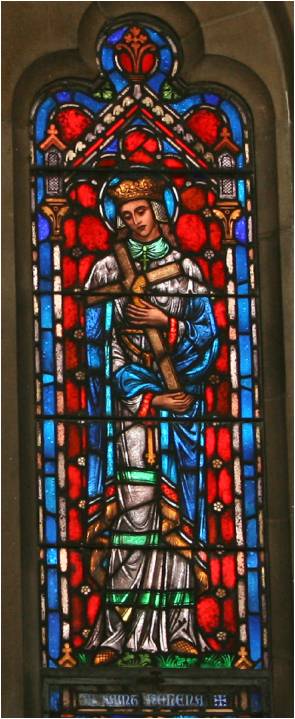
|
She was a woman of low status who became the mother of Emperor Constantine I. She went on an expedition to retrieve relics from Jerusalem and is credited with finding the true cross that Jesus was crucified on.
The hammer and nails were used to crucify Jesus on the cross. She is also credited with finding the nails used in the crucifixion.
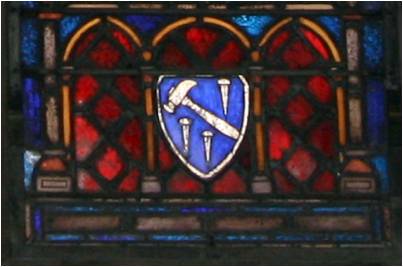
|
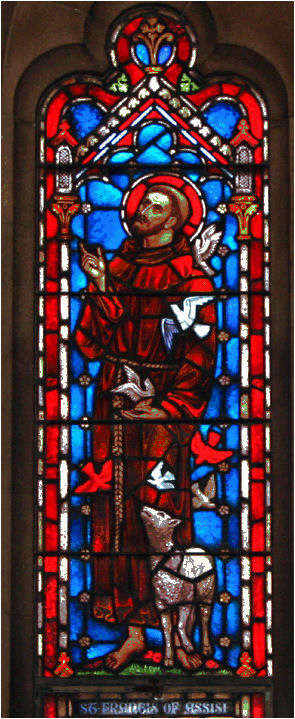
|
Francis renounced his wealth and lived in poverty. He took to the streets preaching and helped to reform the Church. He was well known for his love of animals and all creation. He started the Franciscan order and received the stigmata.
The lamp is used as a symbol of wisdom taken from the parable of the wise and foolish virgins in Matthew 25. The "lamp of learning and wisdom" for St. Francis is the love of poverty and simplicity focusing on the Word of God.
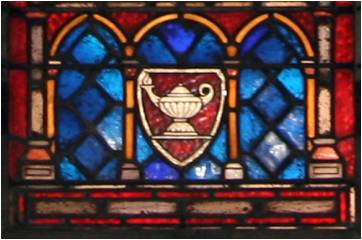
|
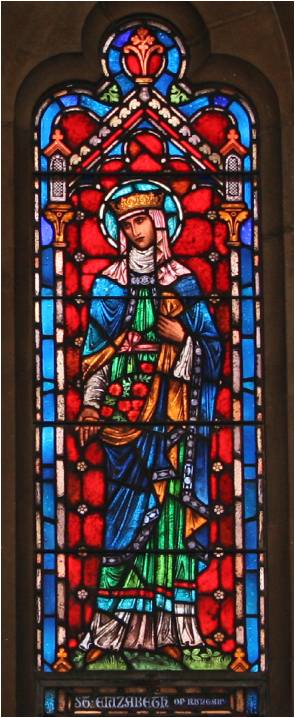
|
She was of royal birth, married royalty and had three children. She shared her wealth with the poor including building a hospital which she worked at. While secretly bringing food to the poor the food turned into roses.
The crowns are symbolic of her royal birth.
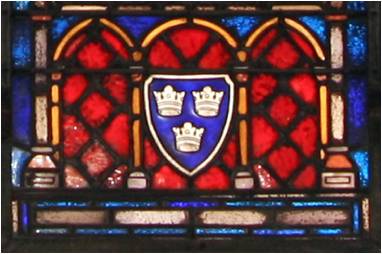
|
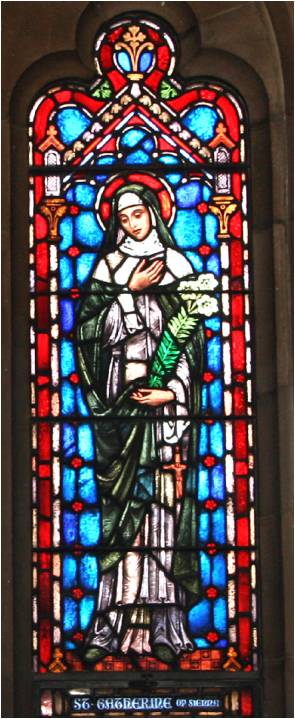
|
She was a 14th century Dominican who was a virgin and lived a very austere life. She helped bring the papacy back to Rome from Avignon France. She received the stigmata, the wounds of Christ. She worked for peace and unity in the Church.
Catherine received a vision from Jesus in which she was offered two crowns, one of gold and jewels and one of thorns. Catherine chose the crown of thorns. After her death she received the stigmata, the wounds of Jesus.
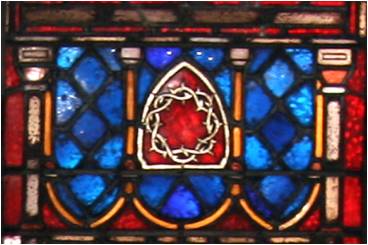
|
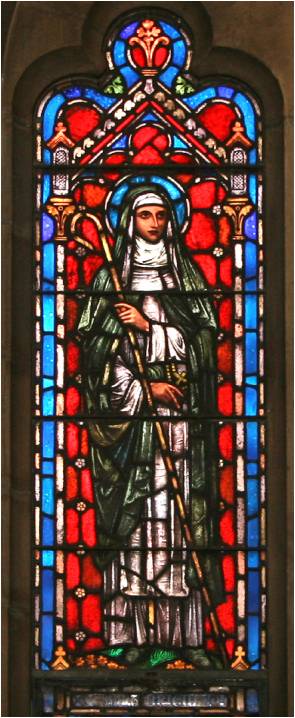
|
She was a friend of St. Patrick of Ireland. The clothing she wears indicates that she was a nun. She carries a staff, the sign of a leader; she became abbess of the first convent in Ireland. She was best known for her concern for the poor and the hungry, always giving to those in need.
The wild goose is the ancient Celtic symbol of the Holy Spirit. The Spirit of God cannot be tamed or contained which is why the symbol of wild goose is used. Brigid lived a life full of the spirit of Truth and Justice.
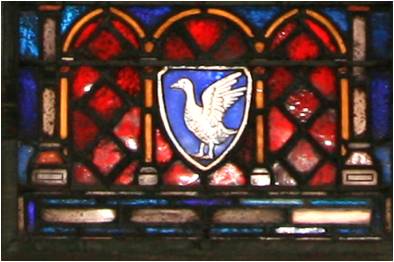
|
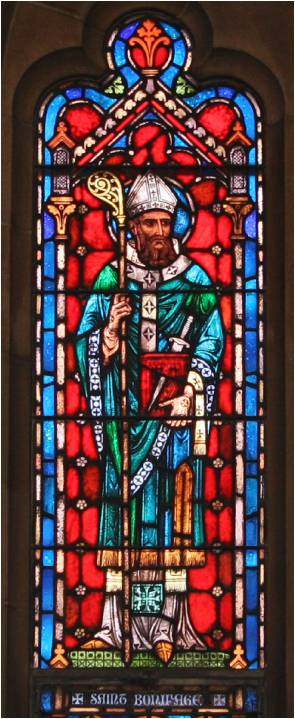
|
The miter and crosier, (hat and staff) indicate that he was a bishop. In fact he was a bishop in Germany who evangelized surrounding countries.
The book with the dagger though it tells the way in which St. Boniface was killed. While preaching the gospel he was attacked and stabbed with a dagger that went through the Bible and into his heart.
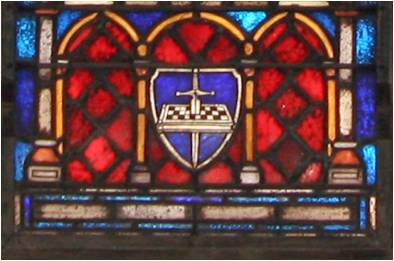
|
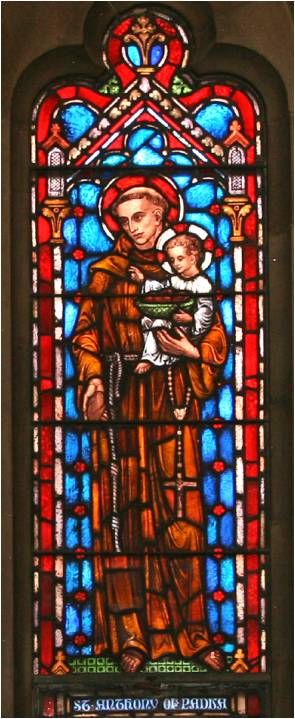
|
Anthony became a Franciscan and was known for his preaching. He was referred to as the "hammer of the heretics". The child Jesus and the loaves of bread indicate what Anthony preached about, the Incarnation and the Eucharist
Although Anthony preached often many would not listen. It is said that he preached to fish because others would not listen, not to convert the fish but because he wanted to give glory to God.
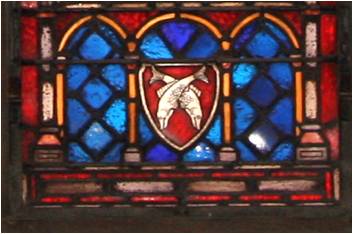
|
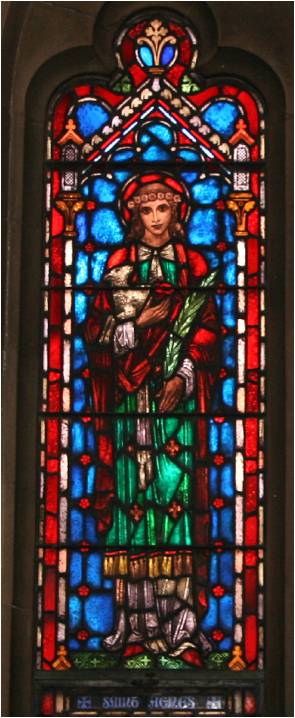
|
She carries a palm branch which is a reminder of Jesus' triumphant entry into Jerusalem celebrated on Palm Sunday that led to Christ's Passion and Death. The palm indicate the saint's martyrdom and victory over sin and death. The Latin word for lamb is agnus which is similar to Agnes' name. Under the reign of the Emperor Constantine, a basilica was built in her honor near her tomb. For centuries, two lambs have been brought to the church and blessed every year. The lambs are then reared in a cloister. When they have grown into sheep, their wool is used to make "palliums" which are special stoles the Pope sends to archbishops to wear on their shoulders as symbols of the sheep carried by the Good Shepherd.
Agnes considered herself betrothed to Jesus, hence the symbol of the ring. The dove is a sign of the Holy Sprit. Agnes was martyred because she would not deny her spouse, Jesus.
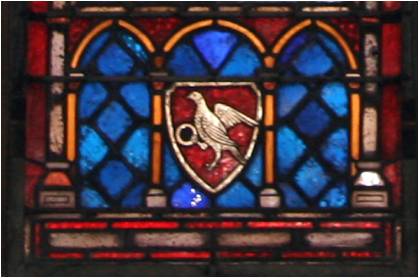
|
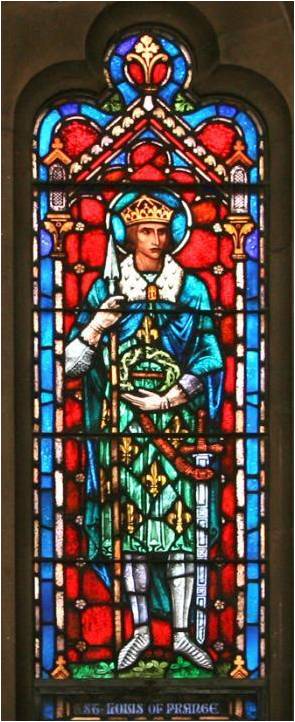
|
He was the King of France in the 13th century who was devoted to his people, founding hospitals, visiting the sick and caring for people with leprosy. He led two crusades.
The fleur-de-lis is a stylized representation of the lily, a symbol of purity, and so is a common reference to the Virgin Mary. The fleur-de-lis is a symbol of royalty, made so by its adoption by kings of France. The triune representation of the fleur-de-lis has also led to its adoption as a symbol of the Trinity.
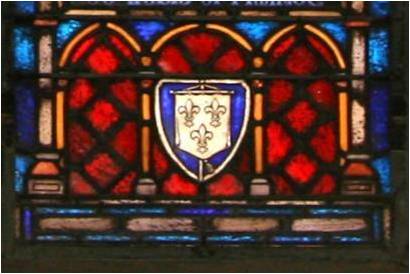
|
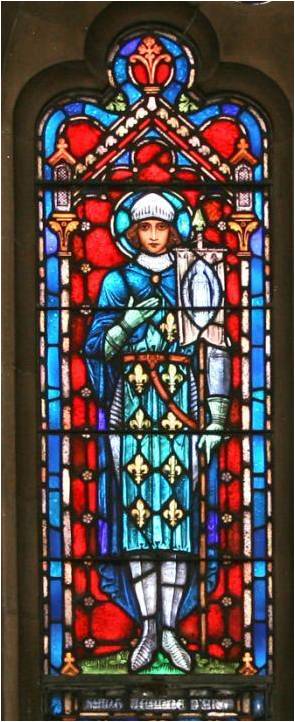
|
Joan of Arc, a peasant girl living in medieval France, believed that God had chosen her to lead France to victory in its long-running war with England.
The fleur-de-lis is a stylized representation of the lily, a symbol of purity, and so is a common reference to the Virgin Mary. The fleur-de-lis is a symbol of royalty, made so by its adoption by kings of France. Joan fought many battles for France.
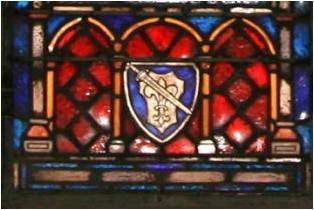
|
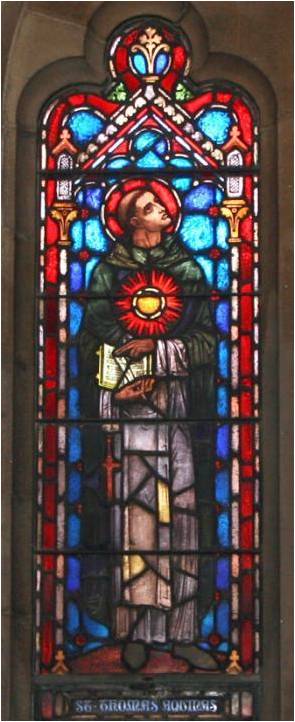
|
Was a Dominican priest and doctor of the Church, patron of all universities and of students. He was one of the greatest and most influential theologians of all time. He was canonized in 1323 and declared Doctor of the Church by Pope Pius V. He wrote "Summa Theologica"
Bene scripsisti de me Thoma- is translated, "you have written well of me Thomas." It refers to Thomas' many and influential writings on theology.
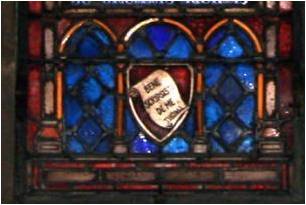
|
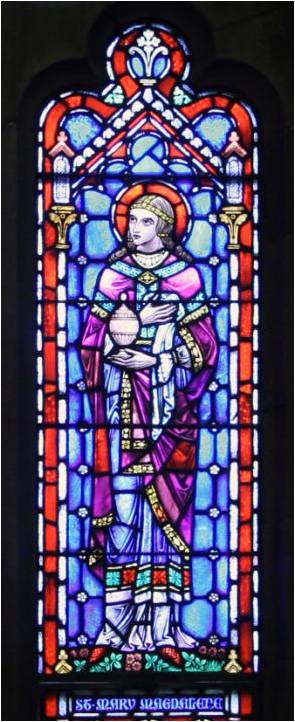
|
She has always been an example of great love and great forgiveness, one of those close to Jesus who grasped the truth of God's love for human beings and spent her life bearing witness to that love.
Tradition says that Mary Magdalene was present at the crucifixion and had possession of the Holy Grail, the cup of Jesus with his blood and brought that by ship to France.
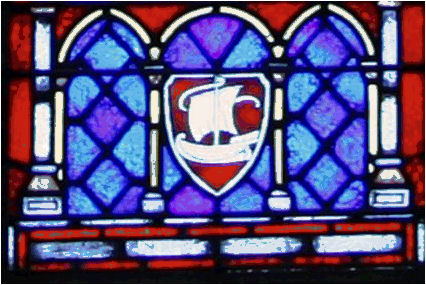
|
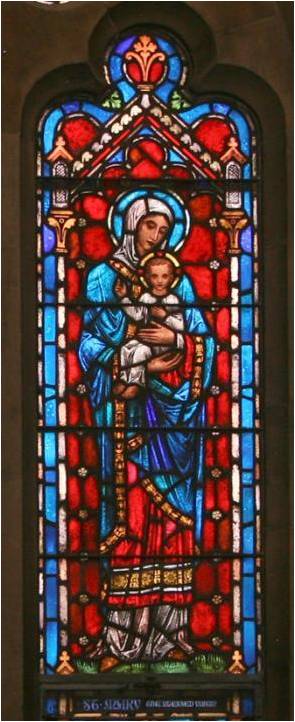
|
It was through Mary's "fiat" that God became incarnate and dwelt among us in order to bring Salvation to the human race. Mary was the first teacher of Her Son. She was His first and most faithful disciple. Mary is the Mother of the Church. With Jesus' words from the cross, "woman behold your Son ... behold your mother", She became the Mother of all the faithful. She is the greatest model of obedience and true discipleship for the followers of Jesus Christ.
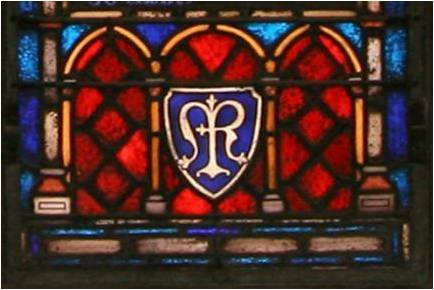
|
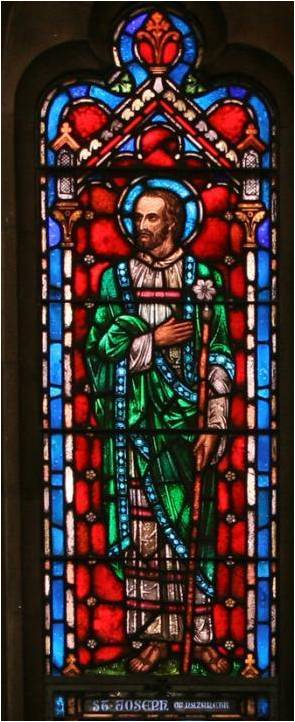
|
The Bible tells us very little of Joseph, but from the early chapters of Matthew and Luke we glean that he was a carpenter by trade, a just and pious man, and a most excellent husband and father. Walking in obedience to God may result in humiliation and disgrace before men. When we obey God, even in the face of adversity and public shame, he leads and guides us.
The saw and the square indicate Joseph's trade as a carpenter.
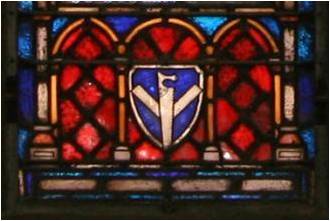
|
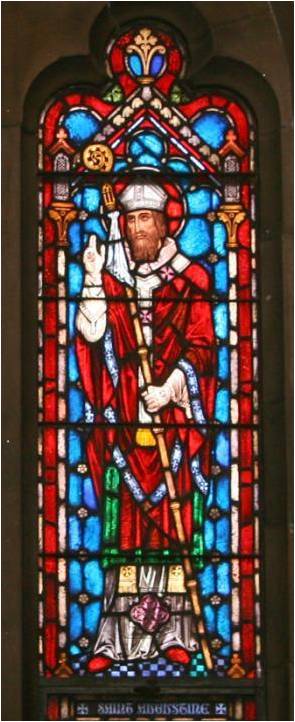
|
Was a 5th century bishop who is one of the most well known saints in the Roman Catholic Church. He was a prolific writer and is known for his story of conversion to the Catholic faith.
Heart: The heart is a metaphor for all that is deepest and truest in one's self. Arrow: In The Confessions of St. Augustine (9.2) he writes: "You have pierced our hearts with the arrow of your love, and our minds were pierced with the arrows of your words." His conversion was as though God had jolted his spiritual heart. Flame: He goes on to describe (13.9) "Your gift sets us afire and we are borne upward; we catch this flame and up we go. In our hearts we climb those upward paths, singing love for God the songs of ascent. By your fire, your beneficent fire, we are inflamed." The symbol shows a heart bursting into flame with flame with love for God.
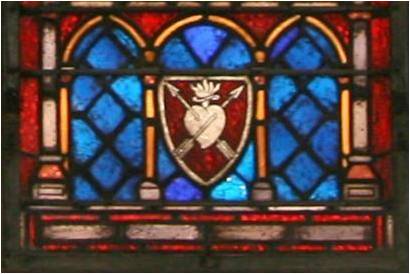
|
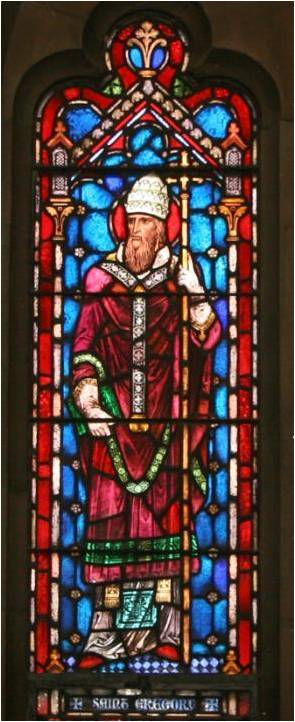
|
A seventh century pope known for liturgical reform, Gregorian chant and numerous writings. He is also a doctor of the Church.
The dove is a symbol of peace, humility, meekness, modesty, divine inspiration, and innocence. St. Gregory embodied all of these during his life of service to the Church, as priest, theologian, and bishop. His modesty, humility, meekness and innocence were reflected in the title he preferred as pope, "Servant of the Servants of God". His peaceful endeavors included negotiations with invading forces to spare Rome, ransoming captives, and the protection of Jewish people.
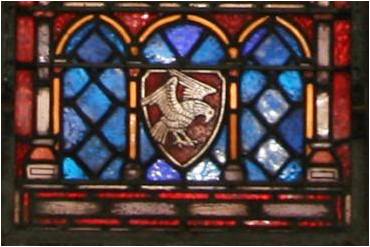
|
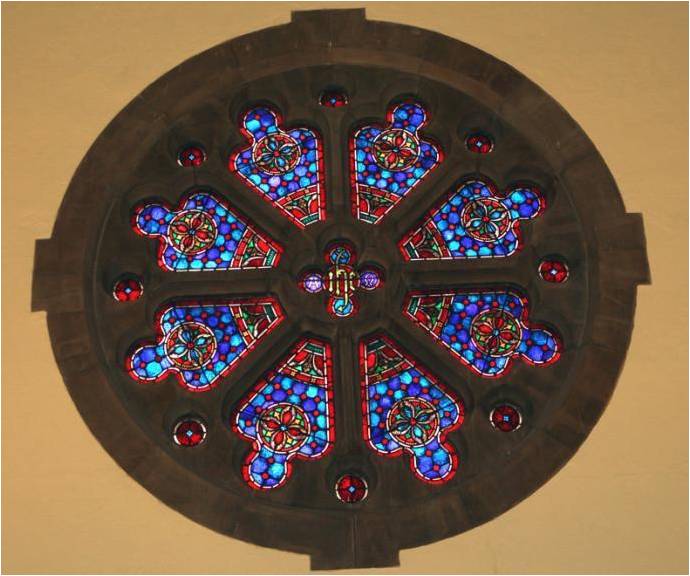
|
The central image in most rose windows is a picture or symbol of Jesus. These windows are meant to symbolize how every bit of the entire cosmos is centered around Christ. The window is round. The circle has been considered the symbol of perfection and of the divine. Also, the "petals" out of which the window is mainly composed, has numeric significance. Eight is the number of the new creation. The seven days of creation will end with the eighth day at the end of time, a new creation in Christ.
|
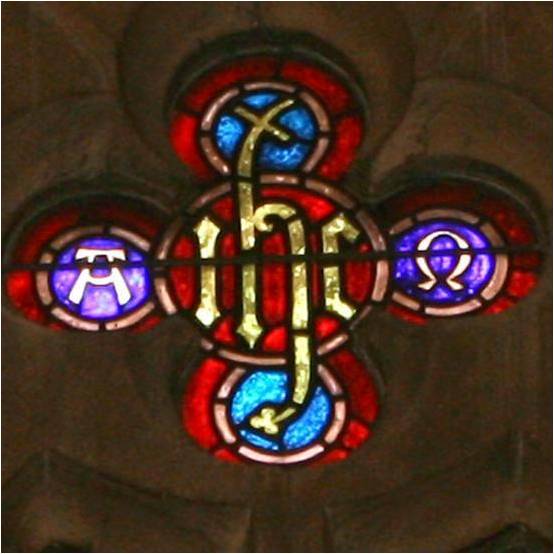
|
The three letters are the first three letters of the name "Jesus" spelled in Greek. At the center of the rose window is a symbol of Christ. On either side of the IHC are the Greek letter "alpha" and "omega" which are the beginning and ending of the Greek alphabet. "I am the Alpha and the Omega" Revelation 1:8
The top of the letter "h" forms a cross on which Christ was crucified. The bottom of the letter "h" forms a trefoil, a symbol that shows Jesus as part of the Trinity.
|
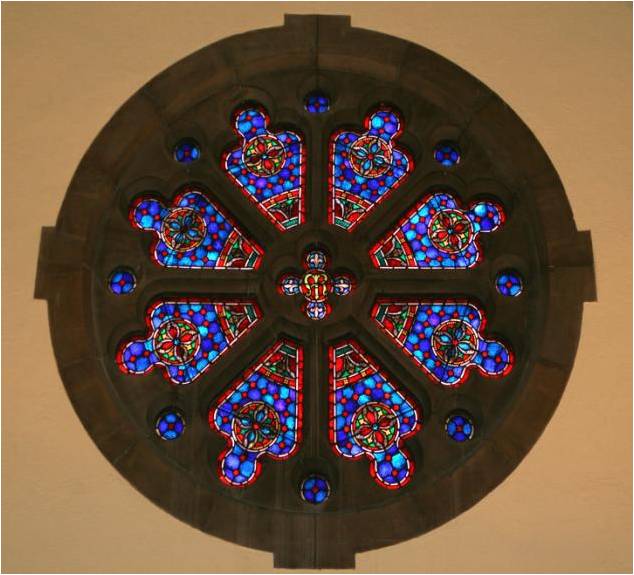
|
Opposite the Rose window, with Christ at its center, is a rose window with the symbol of Mary, through whom Christ was born.
|
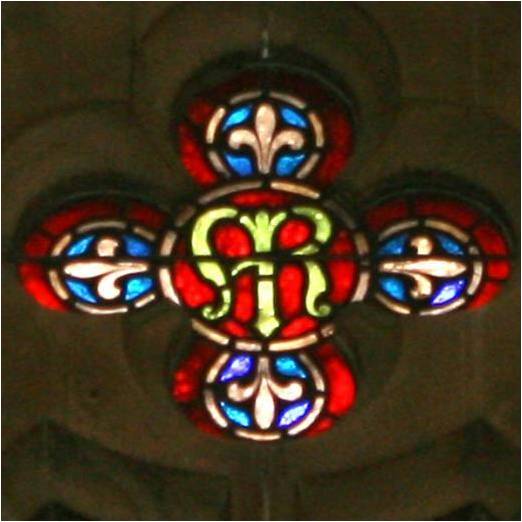
|
The symbol of the R superimposed upon the letter M stands for Maria Regina, Mary, Queen. "a woman clothed with the sun, the head a crown of twelve stars." Rev 12:1
Surrounding the symbol of Mary is the symbol of the fleur-de-lis .
The fleur-de-lis is a stylized representation of the lily, a symbol of purity, and so is a common reference to the Virgin Mary. The fleur-de-lis is also a symbol of royalty, made so by its adoption by the kings of France. The triune representation of the fleur-de-lis has also led to its adoption as a symbol of the Trinity.
|
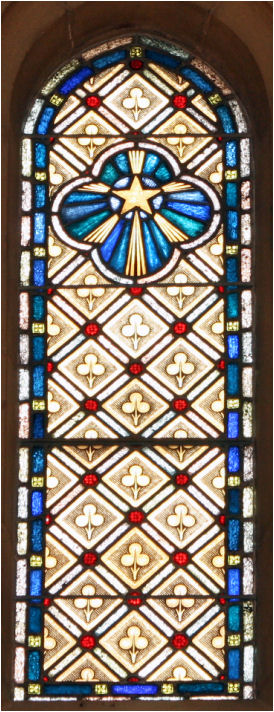
|
The five-pointed star is the star of Bethlehem. Shaped roughly like a human being, it represents Jesus' incarnation.
After Jesus was born in Bethlehem in Judea, during the time of King Herod, Magi from the east came to Jerusalem and asked, "Where is the one who has been born king of the Jews? We saw his star in the east and have come to worship him." Matt. 2:1
The star symbolizes the Epiphany, the revelation of God to humankind and the coming of the good news of redemption to all.
|
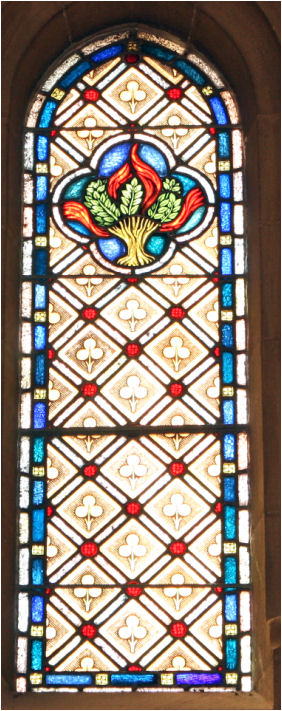
|
An Old Testament story of God being made present to Moses. There the angel of the Lord appeared to him as fire flaming out of a bush. When he looked, although the bush was on fire, it was not being consumed. Ex 3:2 God called out to him from the bush: Moses! Moses! He answered, "Here I am." Ex 3:4 God then leads Moses' people out of slavery.
The window is located in the sanctuary, it is opposite the symbol of the Star of Bethlehem that led to the birth of Jesus. And behold, the star that they had seen at its rising preceded them, until it came and stopped over the place where the child was. Mt 2:9
The Divine is made present to the world though the burning bush in the Old Testament and through Jesus in the flesh in the New Testament.
|
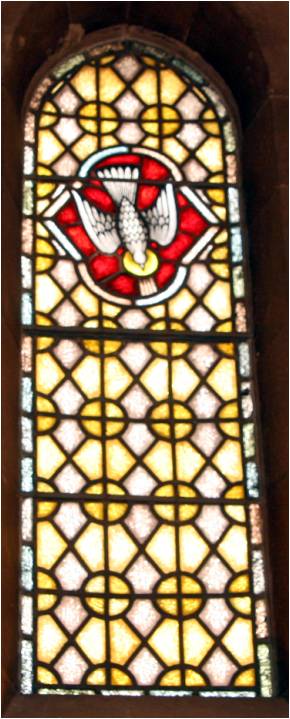
|
The Dove is a symbol of the Holy Spirit. It is taken from the story of Jesus' baptism, where the Spirit descended on him in the form of a dove. After Jesus was baptized, he came up from the water and behold, the heavens were opened [for him], and he saw the Spirit of God descending like a dove coming upon him. Mt 3:16
This window is located by the baptismal font in St. Patrick's Church. Just before the baptizing with water the priest says, "My dear brothers and sisters, we now ask God to give this child new life in abundance through water and the Holy Spirit." Then the person is baptized, "In the name of the Father, and the Son, and the Holy Spirit."
|

|
|